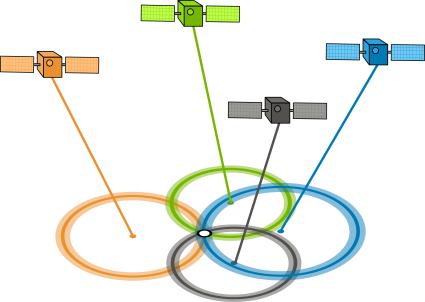
Have you ever wondered about your GPS accuracy?
A well-designed GPS receiver can achieve a horizontal accuracy of 3 meters or better.
For vertical accuracy, it can achieve an accuracy of 5 meters or better 95% of the time. Augmented GPS systems can provide sub-meter accuracy.
But it’s still not perfect. What are the sources of GPS errors that can leave you meters off your mark?
What Lowers GPS Accuracy?
Here are possible ways that can lower the accuracy of a GPS receiver.
For example, the geometry, atmospheric conditions, and even nearby objects can reduce the quality of a GPS signal.
Here are the main causes of error and degradation:
GDOP/PDOP – Geometric/Position Dilution of Precision
GDOP (geometric dilution of precision) or PDOP (position dilution of precision) describes the error caused by the relative position of the GPS satellites.
Basically, the more signals a GPS receiver can “see” (spread apart versus close together), the more precise it can be.
From the observer’s point of view, if the satellites are spread apart in the sky, then the GPS receiver has a good GDOP.
But if the satellites are physically close together, then you have poor GDOP. This lowers the quality of your GPS positioning potentially by meters.
READ MORE: Trilateration vs Triangulation – How GPS Receivers Work
Atmosphere Refraction
The troposphere and ionosphere can change the speed of propagation of a GPS signal. Due to atmospheric conditions, the atmosphere refracts the satellite signals as they pass through on their way to the earth’s surface.
To fix this, GPS can use two separate frequencies to minimize propagation speed error. Depending on conditions, this type of GPS error could offset the position anywhere from 5 meters.
Multipath Effects
One possible error source in GPS calculations is the multipath effect. Multipath occurs when the GPS satellite signal bounces off of nearby structures like buildings and mountains.
In effect, your GPS receiver detects the same signal twice at different ranges. However, this error is a bit less concerning and could cause anywhere from 1 meter of position error.
Satellite Time and Location (Ephemeris)
The accuracy of a GPS satellite’s atomic clock is one nanosecond for each clock tick. That’s pretty impressive stuff.
Using the trilateration of time signals in orbit, GPS receivers on the ground can obtain accurate positions. But due to the inaccuracy of the satellite’s atomic clock being synchronized, this can offset a position measurement by 2 meters or so.
The ephemeris information contains details about that specific satellite’s location. But if you don’t know their exact location at a particular time, this can be a source of error.
READ MORE: Geosynchronous vs Geostationary Orbits
Selective Availability
Before May 2000, the United States government added time-varying obfuscated code to the Global Positioning System. Except for privileged groups like the US military and its allies, this intentionally degraded GPS accuracy.
This whole process of degrading a GPS signal is called selective availability. With selective availability enabled, signals added 50 meters of error horizontally and 100 meters vertically. All things considered, this significantly reduced GPS accuracy.
At the time, differential GPS was able to correct. But after 2000, this source of GPS error no longer was much of a concern as the selective availability switch was turned off.
How to Improve GPS Accuracy
Despite all the potential types of errors that can reduce the accuracy of a GPS, there are ways to improve accuracy.
For example, the two major techniques are:
- GPS Differential Correction
- Satellite-based Augmentation System (SBAS)
Let’s take a closer look at how these two GPs correction methods work.
Differential GPS
DGPS receivers improve accuracy using two receivers because ground-based receivers can take accurate measurements of the error.
As long as the stationary GPS receiver detects the same satellite signals as your GPS receiver, it can send you correction data based on its precisely surveyed location.
Satellite-based Augmentation System (SBAS)
This augmented system broadcasts the corrected error in real-time along with the GPS signal.
As a matter of fact, this is the principal idea of a satellite-based augmentation system (SBAS) and can provide sub-meter GPS accuracy.
A Guide to GPS Accuracy
HDOP/PDOP, multipath and atmospheric effects are some of the common sources of GPS error.
All of these types of GPS errors could lower GPS accuracy.
With the selective availability switch now turned off, we have gained significant improvements in GPS accuracy.
And with techniques like Differential GPS and Satellite-based Augmentation Systems (SBAS), positions can improve to sub-meter accuracy.